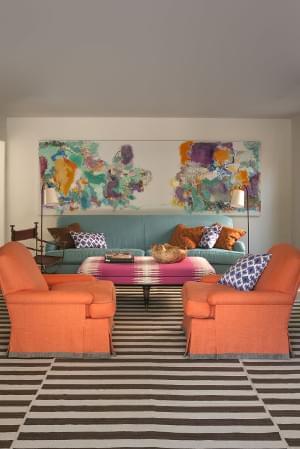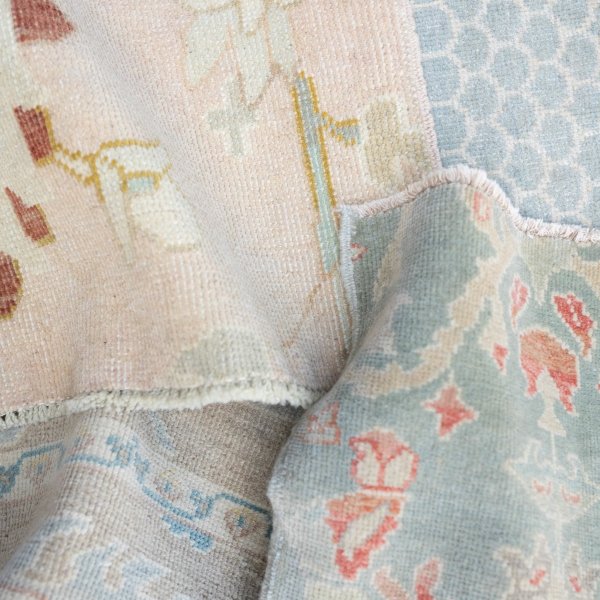Rug Guides: Dhurries
What is a Dhurrie Rug?
Dhurries hail from India where the climate historically necessitated year-round and hyperfunctional use. Dhurrie rugs are lightweight and flat-woven on a horizontal loom from either cotton or wool. They are sturdy and humble rugs, admired for their natural and simplistic nature.
History of Dhurrie Rugs

For centuries, dhurries were mostly used as floor coverings; most social interactions of the time took place on the ground. Furthering their range of capabilities, dhurries were also used for protection against heat and cold. They also appealed to both royalty and commoners. Though when woven for a royal setting, metallic threads were often added to dhurries to embellish and adorn otherwise traditional designs.
Interestingly, between 1880 and 1920, dhurries were woven in Indian prisons. These jail-woven dhurries in particular meet the highest standards and design and execution. It is said that this intense focus on weaving in prison led to an overall renaissance of the craft when it was previously in danger of disappearing.
As Britain's influence grew in the 19th century, so did the popularity of European designs. Particularly, Victorian floral patterns. In the mid-20th century, traditional dhurrie motifs, like stripes, gave way to more intricate weaving work. Similarly, a wider variety of vibrant colors came to take the place of the commonly-used blue and red hues. This gave dhurries a more commercial and stylish appeal. The designer dhurrie became a hot commodity when American carpet designer Irwin Carey commissioned famed Indian weaver Shyam Ahuja to manufacture durries for him in the 1960s.
Dhurries usually feature “dovetail joints,” which allows the weaver to change colors without breaking the weave. Easy to maintain, comparatively affordable, and reversible, a dhurrie can be a simple addition to any room, be it modern or traditional.
Flatweave Design
Dhurries’ tight weaves make cleaning the rugs easier and more practical than other rugs. Perhaps most unique about the dhurrie is its lack of backing and the resulting ability to be reversed. The pattern is the same on each side of the rug, save for a slight variation in colors. The tight weave also means they are among the most durable types of rugs.
Unlike most other rugs, the weft (threads that run horizontally on a loom) is the only visible part of the rug, with the rug warp (vertical threads) only being seen at the fringes.
Another benefit of this weaving technique that makes Dhurrie rugs stand out is that they are invulnerable to insects such as silverfish, which can destroy carpets.
Styles, Patterns & Colors
Dhurrie rugs are handwoven by skilled artisans to create a textile with natural fibers that are not only durable and highly functional, but versatile for home decor.
A great area rug for the living room, office, bedroom, or high-traffic areas, Dhurrie flatweave rugs come with a wide range of floral patterns, geometric designs, and chevrons (zig-zag z-shaped patterns).
Indian dhurries are crafted with various dyes and colors, from vibrant to muted and modern.
What are Dhurrie Rugs Made From?
They are made from one of four materials, cotton, wool, jute, and silk, or a combination of those materials. To make the rug, the material is first broken down so it can be converted into a thread and then used in the handweaving process.
How to Wash a Dhurrie Rug
Dhurrie rugs are durable and generally easy to clean. For the best quality cleaning and removal of stains contacting our professional services is suggested.
Maintenance Cleaning
- Once a week gently brush both sides of the rug to remove dirt and debris.
- Vacuum the rug about once a week with a handheld vacuum.
To Clean Spills
Use a paper towel or cloth to dab the spill until all the liquid has been absorbed. Do not rub the spill as that will spread the liquid around and may cause more staining.
To Clean Dried Stains
Use a soft brush to gently scrub the stain, then use a handheld vacuum on the rug.
If the stain persists, put a drop of dish soap on the stain and use a damp cloth to blot out the stain. If this does not remove it, it is suggested to use a professional cleaning service so the rug is not damaged.
Frequently Asked Questions
Where are Dhurrie rugs made?
They are made in India, with some of the primary dhurrie-producing regions being Rajasthan, Haryana, and Madhya Pradesh.
Are Dhurrie Rugs Made from Wool or Cotton?
They are most commonly made from wool or cotton but are also made from jute and silk.
What is the difference between a Dhurrie and a carpet?
The primary differences are that a Dhurrie has no pile while a carpet does, carpets are hand tufted and hand knotted while durries are woven, and dhurries are reversible while carpets only have one side.
What is the difference between a Dhurrie and a Kilim?
Both Dhurrie and Kalim are flatweave rugs, with the main difference being their design - Kalims tend to be more boldly colored while Dhurries tend to have more pastels and muted colors along with flowy, stylized designs.
You cart is empty. Shop now
